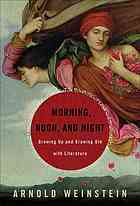
Morning, Noon, and Night
Finding the Meaning of Life's Stages Through Books
کتاب های مرتبط
- اطلاعات
- نقد و بررسی
- دیدگاه کاربران
نقد و بررسی

November 22, 2010
This sprawling amalgam of literary criticism, survey, and memoir encompasses the passion of a comp-lit professor over the course of a career. Steeped in the writings of many Western cultures and times, Weinstein tours not only traditional forms, but the occasional graphic novel (Art Spiegelman's Maus) and film (Bergman's Wild Strawberries) to derive the verities of experience—the ways humans mature and exit life. The number of authors and works covered is staggering. Among the favored: William Blake, Sophocles, Marguerite Duras, Balzac, Faulkner, Dostoyevski, Joyce, Proust, and Ibsen, some relatively obscure (Tarjei Vesaas, for one), some more contemporary (Toni Morrison). The book is at its best when Weinstein zeroes in on eroticism, love, and remembrance. But all too often the juxtaposition of vastly different writers and periods feels arbitrary and forced. In the second half of the book, "Growing Old," Weinstein returns to a number of authors and their works, showing a change in perspective—yet only to confirm suspicions born of experience: that first discovery, like first love, is always the most exciting.

October 1, 2010
Weinstein (Comparative Literature/Brown Univ.; Northern Arts: The Breakthrough of Scandinavian Literature and Art, from Ibsen to Bergman, 2008, etc.) eloquently mines the literary canon for rites-of-passage stories.
In this beautifully, tenderly conceived work, the author employs these seminal texts from Shakespeare to J.M. Coetzee to illuminate both the experience of his young students facing the beginning of their life's journey and also his own, as a man well into his sunset years and looking back at the journey's end. He uses as point of departure (and title) Oedipus's answer to the Sphinx's riddle—"What is the creature that is on four legs in the morning, two legs at noon, three legs at night?"—to delve into these stories as excellent depictions of man at various stages of life. With marvelous clarity gained from three decades of teaching, Weinstein addresses the trajectory of growing up to growing old, moving from Oedipus's own blindness and lack of agency in perpetrating his tragedy, to William Blake's vision of a cruel collusion in acculturation gained in the breathtaking "Chimney Sweeper" poems, to the hard-knock lessons of the picaresque Lazarillo de Tormes and Alice Walker's The Color Purple. The author also finds protagonists embittered by the illusory "final harvest," forsaken and disempowered in their old age—from King Lear to Jean Racine's Phèdre and Tennessee Williams's A Streetcar Named Desire. Throughout this astute, elegant text, Weinstein reminds us why we read ("Art makes life visible") and why these stories are still especially relevant—"as that special mirror that shows up both how others have come through and how we might learn from them." Chapters treating the theme of love as a "basic motor force" prove particularly incandescent, and with certain texts in particular—e.g., Tarjei Vesaas's The Ice Palace, Faulkner novels, King Lear—the author attains a pitch of passionate rhapsody.
From familiar works to those not so well-known, Weinstein expertly extracts their timeless lessons.
(COPYRIGHT (2010) KIRKUS REVIEWS/NIELSEN BUSINESS MEDIA, INC. ALL RIGHTS RESERVED.)

November 1, 2010
In great authors, Weinstein finds greater help in understanding the transitions from childhood to adulthood and from maturity to old age than in any psychologist. In Dickens Pip, for instance, readers experience the cost of strivinghalf-blinded by wild ambitiontoward an ill-conceived manhood, and in Bront's Catherine and Heathcliff, we contemplate the long-lasting harm inflicted by misdirected youthful passion. On the other hand, in James aging Marcher, readers witness the tragic effect of a terribly distorted belief about ones fate. Above all, in Sophocles Oedipus, Weinstein discerns the archetypal representation of the human traumas inherent in the Sphinxs life-stage riddle. As readers will quickly realize, Weinstein focuses on literary figures ensnared in maddening ambiguities, omitting from his study luminous figures such as Shakespeares Prince Hal and Prospero, who triumph over transitional hardship. Still, life changes so often come freighted with perplexity that readers will find much to praise in sobering reflections that free literature from the lethal grip of academic theorizing by connecting it again with real life.(Reprinted with permission of Booklist, copyright 2010, American Library Association.)

























دیدگاه کاربران